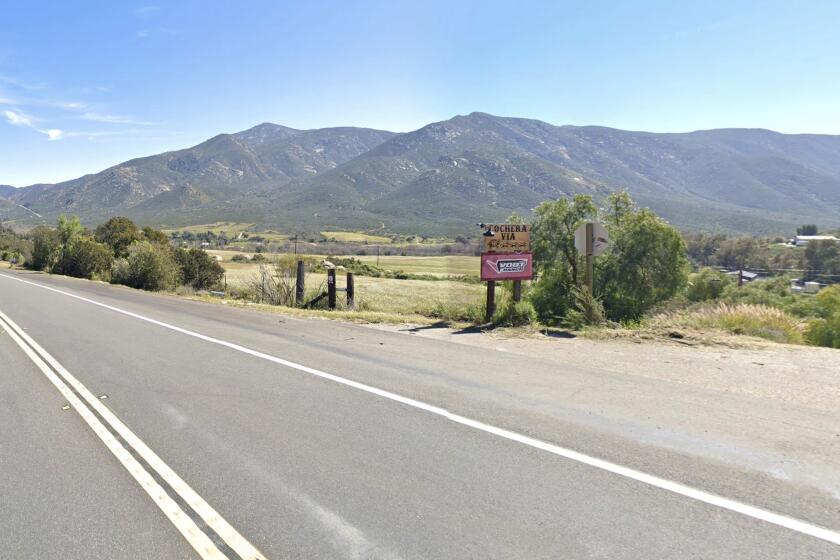U.S. Officials Plan INS Lockup Near Mexican Border
Federal immigration authorities, seeking expanded jail space for foreign nationals convicted of committing crimes in the United States, are planning to build a 1,000-bed detention facility in the U.S.-Mexico border region of Southern California or Arizona.
The lockup, which is expected to be in operation by October, 1992, would be jointly operated by the U.S. Immigration and Naturalization Service and the federal Bureau of Prisons, said Duke Austin, an INS spokesman in Washington.
The plan follows two thwarted INS efforts to hire a private company to build two much smaller detention facilities--one in Oakland and the other on the Viejas Indian reservation in eastern San Diego County. Those two blueprints were withdrawn a year ago after community opposition surfaced and questions were raised about the company’s ability to complete the project.
Under the new plan, Austin said, about half of the 1,000 beds would be used to house foreign nationals serving sentences for federal crimes. The other half would be designed for foreigners being deported after having served their time on criminal convictions in federal, state and local courts. U.S. Bureau of Prisons personnel would staff the facility.
The effort reflects the growing resolve of U.S. authorities to lock up and deport so-called “criminal aliens”--foreign citizens convicted of violent, drug-related and other serious crimes on U.S. soil and now deemed to be dangers to society.
The facility’s future is subject to federal budget priorities. Immigration authorities have requested that Congress provide about $16 million to cover initial costs, but no funds have yet been appropriated.
Although a precise site has not been named, Austin said the facility is likely to be built in either San Diego or Imperial county, both of which share international boundaries with Mexico, or somewhere in southern Arizona, also a border area.
Authorities are seeking to build near the U.S.-Mexico line to facilitate deportation of Mexican citizens, who are expected to constitute 80% of the detainees, Austin said.
“Our most immediate needs are down along the border,” explained Virginia Kice, an INS spokeswoman in Los Angeles.
The new detention space, however, would not be designed for most of the 1,800 undocumented immigrants now arrested daily by U.S. Border Patrol agents in the San Diego area. Most of those are quickly sent back to Mexico after signing a form agreeing to a “voluntary” repatriation. Limited detention space means that most cannot be held for more than a few hours.
Rather, the new jail is aimed at foreigners convicted of crimes mostly unrelated to their immigration status.
Since the 1980s, federal authorities have increasingly sought to subject such felons to formal deportation--a process that, although streamlined by recent revisions of U.S. immigration law, can still drag on for months. Lawmen routinely seek to hold the prospective deportees pending the outcome of their cases, creating a need for detention space.
“The (planned) facility will strengthen our continuing efforts to centralize criminal aliens in order to expedite their removal,” INS commissioner Gene McNary said in a statement to Congress last month, reiterating a continuing INS complaint about a lack of jail space.
Immigrant advocates have voiced reservations about the deportation policy, fearing that some people may be denied bond and “railroaded” back to their homelands without access to proper legal assistance, said Charles Wheeler, director of the National Immigration Law Center, a Los Angeles-based legal aid group.
“They’re basically trying to put the squeeze on these people,” Wheeler said.
Critics have also asserted that immigration lockups nationwide--including those in El Centro, Calif., and outside Brownsville, Tex., and Miami, Fla.--are at times overcrowded and understaffed, creating volatile environments.
Once formally deported, foreign nationals arrested anew while on U.S. territory illegally are subject to federal prosecution and five-year jail terms. Lawmen thus view deportation as an incentive for criminal aliens not to return to the country.
Bids for the construction contract are expected to be sent out by late June, said Austin, the INS spokesman, who added that the lockup’s cost is not known. Officials would like to award the contract by next April 1, Austin said, with construction completed by Oct. 1, 1992.
The proposed lockup would be the largest INS detention facility in the region, surpassing the 450-bed El Centro facility and the 400-bed lockup on Terminal Island in Los Angeles.
It would be similar to two federal centers in Oakdale, La., both of which are operated by the U.S. Bureau of Prisons and house INS detainees.
The INS now has access to about 5,000 detention spaces nationwide in federal structures. Immigration authorities also contract with hundreds of area jails, privately run facilities and other sites to provide incarceration space as needed.
More to Read
Sign up for Essential California
The most important California stories and recommendations in your inbox every morning.
You may occasionally receive promotional content from the Los Angeles Times.






